Gersten J.I., Smith F.W. The Physics and Chemistry of Materials
Подождите немного. Документ загружается.

SYNTHESIS AND PROCESSING OF MATERIALS 383
Thermomechanical processing treatments involve the simultaneous use of both heat
and plastic deformation to achieve desired changes in both the external shape and
the microstructure of a material. The hot rolling of steels in the range T D 1200 to
1300
°
C, for example, achieves several purposes: the reduction in cross section of a
large steel ingot, the breaking down of the original coarse microstructure in the as-
cast material, the reduction of compositional inhomogeneities, and the redistribution
of impurities. As hot rolling is carried out at successively lower temperatures, the
precipitation of carbides, nitrides, and carbonitrides occurs, leading to the pinning of
grain boundaries. As a result, grain refinement (i.e., the achievement of lower average
grain sizes) and dispersion strengthening can both occur during hot rolling, leading to
significant increases in the yield strength of the steel.
The welding of steels to fabricate structural forms is often an unavoidable processing
step which can cause unwanted changes in the microstructure and properties of the
steel in the vicinity of the weld. Fusion welding involves the melting of the steel
in regions near the weld, known as the fusion zone, as well as large increases of
temperature in surrounding areas known as the heat-affected zone. Significant changes
in the microstructure of the steel can occur in both zones, affecting both its corro-
sion resistance and strength. Many of the phase transformations and processes already
described in this section occur in and near the weld. Honeycombe and Bhadeshia
(1996, Chapter 13) present a brief summary of the important effects associated with
the generation of weld microstructures in steels.
W21.11 Precipitation Hardening of Aluminum Alloys
Pure FCC Al metal has the following properties: a low density, , ³ 2700 kg/m
3
,and
a low melting point, T
m
D 660
°
C; high electrical and thermal conductivities; high
ductility in the annealed state; high corrosion resistance due to the thin coating of the
protective oxide Al
2
O
3
. Because of the relatively low strength of pure Al, its alloys
with elements such as Cu, Si, and Mg have found a wider range of applications. The
microstructures of these alloys are characterized by a solid-solution phase, ˛-Al, and
by intermetallic compounds such as CuAl
2
and Al
3
Mg
2
.
Al alloys are typically strengthened by the mechanism of precipitation or age hard-
ening. The precipitation-hardening process involves the use of heat treatments, which
result in precipitation within the original matrix of a uniform dispersion of very small
particles of a second phase. Although a heat-treatment process, precipitation hardening
involves a distinctly different sequence of steps than occur in the heat treatment of
steels, which results in the formation of martensite, for example. Two heat treatments
are typically required, the first for creating a solid solution and the second for accel-
erating the process of precipitation or aging. The first heat treatment takes place at
a temperature near T
e
and for a time long enough to produce a solid solution. The
alloy is then quenched to room temperature to obtain a supersaturated solid solution.
The second heat treatment is then carried out at a lower T to allow the diffusion to
occur which is necessary for formation of the precipitates of the second phase, which
results in the strengthening of the alloy. Precipitation hardening is more commonly
carried out in Al–Cu, Al–Si, Cu–Be, Cu–Sn, and Mg–Al alloys and in Ni
3
Ti and
Ni
3
Al compounds than in ferrous alloys. Precipitation hardening in Ni
3
Al is discussed
in Section 12.8.
To illustrate a specific example of the precipitation-hardening process in Al alloys,
consider the Al-rich side of the Al–Cu equilibrium phase diagram (Fig. W21.24). The
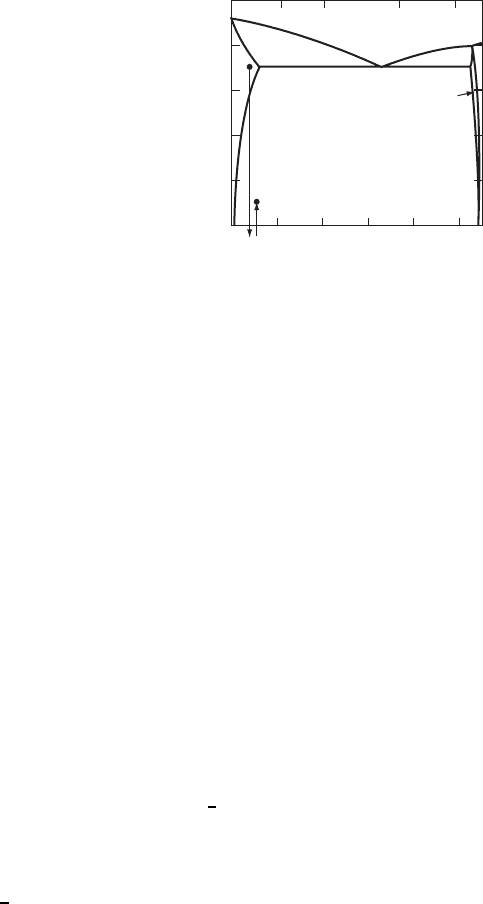
384 SYNTHESIS AND PROCESSING OF MATERIALS
a + L
a
+
q
q + L
L
a
1
3
(250°C)
0 1020304050
510 20 30
2(RT)
Composition [ wt % Cu]
300
200
400
500
600
700
T [°C]
(AI)
Composition [at % Cu]
q
(CuAI
2
)
Figure W21.24. Al-rich side of the Al–Cu equilibrium phase diagram shown to illustrate the
precipitation-hardening process. The two stable solid phases present are the solid-solution ˛-Al
phase and the 8 phase (i.e., the intermetallic compound CuAl
2
). The sequence of treatments
used for precipitation hardening of an Al –1.5Cu wt % alloy is also shown: 1, solid-solution
heat treatment at T ³ 550
°
C; 2, quench to room temperature; 3, precipitation heat treatment at
T ³ 250
°
C. (From ASM Handbook, 9th ed., Vol. 3, Alloy Phase Diagrams, ASM International,
Materials Park, Ohio, 1992, p. 244.)
two stable solid phases present are ˛-Al, which is a solid solution of Cu in Al, and the
8 phase corresponding to the intermetallic compound CuAl
2
. The solubility of Cu in
˛-Al reaches a maximum value of x
e
D 5.6wt%atT
e
D 548
°
C and then decreases
rapidly with decreasing T, reaching ³ 0.02 wt % at room temperature. The initial heat
treatment for obtaining a solid solution takes place near T
e
for Al
1x
Cu
x
alloys with
x<x
e
. Following quenching to room temperature, the Al–Cu alloy then undergoes
a precipitation heat treatment. If the alloy is left either at room temperature for a
few days or is reheated to T ³ 100 to 150
°
C, the Cu atoms are not able to undergo
sufficient diffusion to form precipitates of CuAl
2
. Instead, they rearrange themselves
locally within the lattice on f100g planes in two-dimensional platelets or disks known
as Guinier–Preston (GP) zones. The first structures formed, known as GP-1 zones,are
coherent with the Al lattice and are essentially randomly distributed in the alloy. They
are typically 3 to 6 nm long with thicknesses of 0.5 to 1 nm. Their Cu contents are
deficient with respect to x D
1
3
, the fraction found in CuAl
2
.
Additional aging of the alloy leads to the gradual growth of the GP-1 zones and
then to the formation of a series of phases or precipitates. The larger GP-2 zones,also
known as the 8
00
phase, with lengths ³ 10 nm, widths ³ 1 to 4 nm, and Cu contents
x ³
1
3
are formed next, followed by their conversion into an intermediate 8
0
phase,
which is metastable and incoherent with the Al lattice. The stable 8 equilibrium phase
finally forms from the 8
0
phase when the aging temperature is raised to T ³ 200 to
250
°
C. The 8
0
and 8 phases both have the CuAl
2
stoichiometry but have different
crystal structures. The hardness and strength of precipitation-hardened Al–Cu alloys
reach maximum values when the GP-2 zones (i.e., the 8
00
phase) are formed and then
decreases with further heat treatment as the 8
0
and then the 8 phases appear.
The sequence of microstructures of the supersaturated ˛-Al solid solution and of the
8
00
and 8 phases are illustrated schematically in Fig. W21.25. Precipitation-hardened
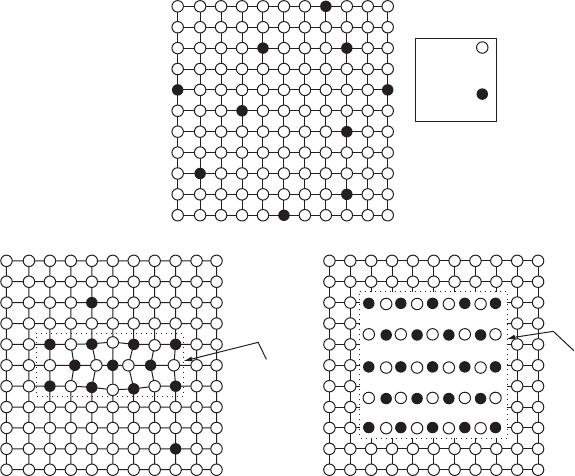
SYNTHESIS AND PROCESSING OF MATERIALS 385
Solvent
(AI) atom
Solute
(Cu) atom
q" - Phase
particle
q - Phase
particle
(a)
(c)(b)
Figure W21.25. Microstructures of (a) the supersaturated ˛-Al solid solution and of (b)the8
00
and (c)the8 phases. The 8 phase has the CuAl
2
stoichiometry. The actual particle or zone sizes
are much larger than shown here. (From W. D. Callister, Jr., Materials Science and Engineering,
2nd ed., copyright 1991 by John Wiley & Sons, Inc. Reprinted by permission of John Wiley &
Sons, Inc.)
Al alloys can in general have complicated microstructures corresponding to mixtures
of the phases mentioned earlier. The strengthening of the alloy can be described by
the Orowan expression, Eq. (W21.25), with the average distance between precipitate
particles. Strengthening is enhanced when significant lattice strain exists at the interface
between the precipitates and the surrounding matrix. This lattice strain is particularly
effective in impeding the motion of dislocations. When aging proceeds to the extent
that the CuAl
2
precipitates become too large and too few in number, they are much
less effective in impeding the motion of dislocations. When this happens, the strength
of the alloy can actually decrease, a phenomenon known as overaging.
W21.12 Synthesis of Metals via Rapid Solidification
As the name indicates, rapid-solidification processing (RSP) of metals involves a rapid
transition from the liquid to the solid state. RSP usually involves the cooling of liquid
metals at sufficiently high rates, ³ 10
3
to 10
9
K/s, so that nonequilibrium composi-
tions, phases, or microstructures that are not ordinarily obtainable at “normal” cooling
rates of ³ 10
2
to 10
2
K/s (³ 10 to 10
5
K/h) can be synthesized. The amorphous or
nanocrystalline microstructures often resulting from the RSP of metals have led to the
use of the term metallic glass. It is ordinarily extremely difficult to produce elemental
metals in an amorphous state due to the ease with which liquid metals crystallize due
386 SYNTHESIS AND PROCESSING OF MATERIALS
to their low viscosities and high diffusivities and the ease with which solid metals
recrystallize. By contrast, materials based on Si–O
4
tetrahedra, such as silicates, form
glasses relatively easily on cooling due to the high viscosity of the liquid.
Metals that have been synthesized via RSP include hard and soft magnetic materials;
high-strength Al, Mg, and Ti alloys; tool steels; shape-memory alloys; Ni-based super-
alloys and brazing materials. Some of the properties of metallic glasses are discussed
in Chapter W12. The random close-packing model for the short-range order found in
metallic glasses is discussed in Chapter 4.
Techniques that are used in RSP to obtain extremely high cooling rates include the
following:
1. Splat cooling. A small, molten drop of metal is incident at high speed onto a
metallic substrate (e.g., copper) held at room temperature or below. A related
method involves the trapping of the molten drop between two cooled surfaces
(e.g., a hammer and an anvil).
2. Melt spinning. A molten stream of metal is projected against a rapidly rotating
surface.
3. Twin-roller quenching. A molten stream of metal is forced between a pair of
rapidly rotating rollers.
4. Plasma or flame spraying. The metal in the form of a powder is introduced into
a high-temperature plasma or flame and then sprayed onto a cooled substrate.
5. Surface melting. A source of thermal energy such as a laser, ion beam, or electron
beam causes a thin surface layer of a metal to melt. The surface layer then
undergoes rapid resolidification as soon as the source of heat is removed.
In the first three techniques listed above, and in similar techniques not mentioned
here specifically, the rapid solidification is achieved by placing as thin a layer of molten
metal as possible in contact with a cooled surface of high thermal conductivity to obtain
as high a rate of heat extraction as possible from the molten metal. As a result, the
materials are typically thin foils or thin, continuous ribbons. The small dimension of
the rapidly solidified material is typically ³ 25 to 50
µm.
Another technique for achieving the rapid solidification of a metal is through the
use of strong undercooling of several hundreds of degrees celsius, as when small,
molten metallic particles are cooled well below their normal melting point by avoiding
nucleation of the solid phase. This RSP technique, known as atomization, involves
breakup of a stream of molten metal into fine particles. In this case once a solid
nucleus forms in a given particle, solidification occurs extremely rapidly due to the high
velocity of the solid–liquid interface, which passes through the particle. The resulting
solid powder usually needs additional processing (e.g., consolidation) before it can be
used to form a solid object. Additional processing of RSP materials is often needed to
develop microstructures with the desired mechanical properties. Strong undercooling
can, of course, also occur during the rapid cooling processes listed above.
A necessary condition for obtaining nonequilibrium compositions via RSP is that the
growth rate or solidification velocity
v
sl
be greater than the diffusive speed v
d
D D/d
a
of the solute in the liquid metal. Here D is the thermal diffusivity, ³ 10
9
m
2
/s, of the
solute and d
a
is the interatomic distance, ³ 3 ð 10
10
m. Other important materials
parameters that influence the degree of solute incorporation in the solid phase include
the solid–liquid interface energy density
sl
and the latent heat H
m
and entropy
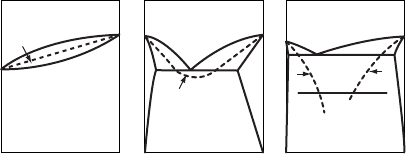
SYNTHESIS AND PROCESSING OF MATERIALS 387
change S
m
for the liquid–solid transition. When v
sl
> v
d
³ 0.03 m/s, it follows that
solute can be trapped at above-equilibrium levels in the solidifying solvent. In the limit
v
sl
× v
d
, the solute distribution coefficient K will approach 1. This has been observed
in doped Si and in metallic alloys when
v
sl
> 5 m/s. For comparison, a typical value
for the normal cooling of a steel ingot is
v
sl
³ 3 ð10
5
m/s.
It is useful to discuss RSP in terms of the equilibrium phase diagram of the system
in question even though the process of rapid solidification leads to nonequilibrium
solid products. Consider the solid solution and eutectic binary phase diagrams shown
schematically in Fig. W21.26. Indicated in each diagram is the curve of T
0
versus
composition, where T
0
is the temperature at which the liquid and solid phases of the
same composition have the same Gibbs free energy. For the eutectic system shown
in the middle, where the two solid phases have the same crystal structure, there is a
smooth T
0
curve. In the right-hand phase diagram where the two solid phases have very
limited mutual solid solubilities, the T
0
curves do not intersect. In all three cases shown
in Fig. W21.26, the solid formed will have the same composition as the liquid when
cooling is rapid enough so that solidification occurs at T<T
0
. Under these conditions
the solidification rate can exceed the diffusion rate in the liquid so that the components
cannot redistribute themselves in the liquid phase. The glass-transition temperature T
g
is shown in the right-hand phase diagram. In a glass-forming system where T
g
is so
low that it cannot be readily reached via rapid solidification, a dispersion of particles
of a second phase can then occur in the primary matrix.
Metastable phases can also be formed when cooling rates are sufficiently high. In
addition to the important example of the Fe–C system, where Fe
3
C is a metastable
product, a wide variety of interesting icosohedral metastable phases of Al with fivefold
rotational symmetry (e.g., Al
6
Mn
1x
,Al
6
Mn
1x
Fe
x
,Al
12
Fe
1x
Mo
x
,andAl
62
Cu
26
Fe
12
)
have been prepared via RSP. An RSP phase diagram using information obtained by
heating the surfaces of Al-rich Al–Mn alloys with a scanned electron beam is presented
in Fig. W21.27. Here the solid phases obtained for a range of scan (i.e., solidification)
velocities
v
sl
from 0.001 to 1 m/s and for Mn concentrations from 0 to 30 wt %
are shown. Icosohedral (fivefold symmetry) and decagonal (tenfold symmetry) phases
in the form of dendrites in an Al-rich matrix are obtained for
v
sl
greater than about
0.02 m/s and for more than ³ 18 wt % Mn. The solid-solution phase ˛-Al extends up to
³ 14 wt % Mn for
v
sl
greater than about 0.03 m/s, well beyond the equilibrium eutectic
x (composition)
T
(a)
x (composition)
T
(b)
x (composition)
T
(c)
0101
T
0
T
0
T
0
T
0
T
g
Liquid (I)
Solid
solution (s)
Eutectic
Eutectic
II
l+s
01
Figure W21.26. Solid-solution and eutectic binary phase diagrams are shown schematically,
with the temperature T
0
at which the liquid and solid phases of the same composition have the
same Gibbs free energy indicated.
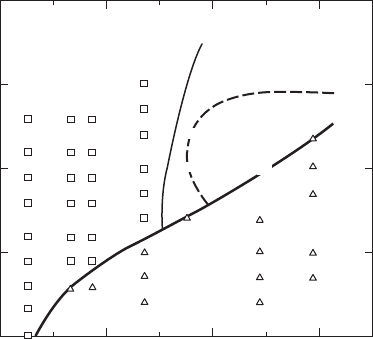
388 SYNTHESIS AND PROCESSING OF MATERIALS
Intermetallic
phases
Scan velocity, cm/sec
Manganese concentration, wt %
0.1
1
10
100
1000
0 102030
α
-AI
0.8
0.8
0.5
0.5
1
0.6 0.6
0.4 0.4 0.4
0.2
0
0
1
Icos.
T
Figure W21.27. RSP phase diagram. The numbers indicate the relative fractions of the inter-
metallics that are icosohedral; from x-ray diffraction intensities. The region labeled T is a
decagonal region. [From R. J. Schaefer et al., Metall. Trans., 17A, 2117 (1986).]
limit of 1.8 wt % at T
e
D 658
°
C. The possibility of obtaining metastable phases in
Al–Mn alloys is enhanced due to the many different intermetallic compounds found
in Al-rich alloys and also due to their relatively low growth velocities.
Despite the initial and continuing enthusiasm for the RSP technique, many of the
hoped-for applications have not yet materialized, due in part, perhaps, to a lack of
fundamental knowledge concerning the processes occurring during rapid solidifica-
tion. It is, of course, an extremely difficult problem to control the microstructure,
morphology, and stoichiometry of a rapidly solidified material under processing condi-
tions that are so far from equilibrium. The consolidation of RSP-generated materials
into useful forms without causing a degradation of their desirable as-synthesized prop-
erties has also proven to be difficult.
W21.13 Surface Treatments for Metals
Most pure metals are thermodynamically unstable with respect to oxidation and other
environmental chemical reactions. As a result, a wide variety of physical and chemical
processing procedures is used to modify the surface properties of metals in order to
improve their corrosion resistance, wear resistance, and surface hardness. Some of these
procedures have been mentioned in Chapter W12 and include electroplating, chemical
reactions, vapor deposition, ion implantation, and thermal reactions. In addition, the
electrolytic anodization of Al resulting in the formation of an oxide layer has been
discussed in Section 19.11. Two additional surface-treatment procedures are discussed
briefly here: surface carburizing and nitriding and the intense-pulsed-ion-beam (IPIB)
surface treatment.
The surface carburizing and nitriding of metals are both processes that involve
changing the chemical composition of the metal in a surface layer. They can be
achieved using a variety of techniques for introducing C and N into the material.
SYNTHESIS AND PROCESSING OF MATERIALS 389
Gas carburizing (in the austenite region near T D 1000
°
C) and nitriding (in the ferrite
region near T D 500
°
C) of low-carbon steels typically involve heating the steel in C-
or N-containing atmospheres (CH
4
or NH
3
), which leads to the rapid diffusion of C
or N atoms into the near-surface region known as the case (hence the use of the term
casehardening). Other metallic substitutional alloying elements, such as Ni, Mn, and
Cr, are not affected by this treatment, due to their much lower diffusivities in iron.
Analogous processes known as carbonitriding (or nitrocarburizing)andboronizing
can also be used for surface hardening.
The resulting spatial distribution of C in the steel depends on both the temperature
and time of the carburizing process. The carbon concentration is given approximately
by the solution of Fick’s second law of diffusion [see Eq. (W6.2)]. Typical C concen-
trations obtained in the surface layer are ³ 0.8 to 1 wt % (i.e., well below the solubility
limit of C in austenite). As the steel is cooled from the carburizing temperature, the
microstructure that develops varies with depth into the material due to the varying C
concentration. Pearlite and cementite are formed at and just below the surface, then
only pearlite when the C concentration has fallen to the eutectoid composition, followed
by a mixture of pearlite and ferrite at greater depths. For most steels carburized for 5
to 10 h, the thickness of the carburized surface layer is from 0.5 to 2 mm.
Following the carburizing step, additional heat treatments known as casehardening
are necessary to form precipitates of martensite, which result in the formation of a
wear-resistant surface layer on the steel. This subsequent heat treatment usually takes
place in the austenite phase near T D 850
°
C and is followed by rapid quenching to
form martensite. A martensite tempering heat treatment is then carried out in the range
T D 150 to 200
°
C to relieve stresses.
Surface nitriding procedures are ordinarily employed for steels containing the
alloying elements Al, V, Cr, and Mo and result in surface layers which are harder than
those which are obtained by carburizing. Nitriding is usually carried out in an NH
3
atmosphere and at lower temperatures, and therefore for longer times, than for the case
of carburizing since the eutectoid temperature T
e
in the Fe–N system is only ³ 590
°
C.
The possible microstructures appearing in the Fe–N system are more complicated than
in the Fe–C system since more than one stable iron nitride (e.g., Fe
4
N, Fe
3
N, and
Fe
2
N) can exist in the nitrided surface layer, depending on the processing conditions.
The relatively N-rich compound Fe
3
N is typically found near the surface, while Fe
4
N
is found at a greater depth where the diffused N concentration is lower. In addition,
precipitates of the nitrides of the alloying elements Al, V, Cr, and Mo are also found
in the nitrided surface layer. As a result, the surface layer can be quite hard due to
the dispersion-strengthening mechanism. In contrast to carburizing, no additional heat
treatment is required to harden the nitrided surface layer.
In the case of surface hardening via carbonitriding or boronizing, carbonitrides and
borides are formed instead of carbides or nitrides. The Fe
2
B phase is preferred over the
FeB phase because it is less brittle and also because the resulting casehardened surface
is under compressive stress. Boronized layers on plain carbon steels are typically two
or three times harder than carburized layers on the same steels.
The carburizing and nitriding of steels can also be carried out in CH
4
/Ar/H
2
or CO
2
and NH
3
or N
2
/H
2
plasmas, respectively, with the result that the necessary treatment
times and temperatures can be greatly reduced. In addition, the plasma can clean the
surface via sputtering, activate the chemical species so that they interact more readily
with the surface to be hardened, and even heat the surface. Plasma nitriding is also used
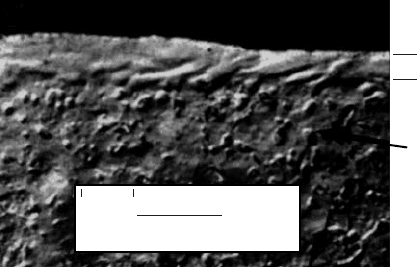
390 SYNTHESIS AND PROCESSING OF MATERIALS
to improve the surface hardness and wear resistance of Ti alloys containing Al and
V. Four distinct layers can be found in the surface region following plasma nitriding
at T D 800
°
C for 13 to 15 h: a 0.3 to 0.5-µm surface layer of FCC υ-TiN, a 1.7 to
2-
µm layer of tetragonal ε-Ti
2
N, a thin layer of Ti
2
AlN, and then the diffusion zone
containing nitrogen-stabilized ˛-Ti. An alternative source of energy is employed in the
laser nitriding of Fe and Ti in a N
2
atmosphere which leads to improved hardness and
corrosion resistance.
The intense-pulsed-ion-beam (IPIB) surface treatment is a recently developed
thermal process that causes rapid heating and melting of the surface layer of a
metal, followed by extremely rapid cooling, ³ 10
9
K/s, of the layer. This procedure,
which can be considered to be a type of rapid-solidification processing, results in
nonequilibrium microstructures such as amorphous, metastable, or nanocrystalline
layers in the surface region. Such surface layers on tool steels and high-temperature Ti
alloys have greatly improved surface hardnesses and wear and corrosion resistances.
The plasma-immersion ion-implantation (PIII) procedure used to implant dopant ions
into semiconductors is also used to implant N into the surfaces of metals in order to
improve wear resistance.
The intense pulsed ion beams are typically composed of H or heavier ions. A single
ion pulse containing ³ 10
13
to 10
14
ions/cm
2
leads to the implantation of ionic species
at the level of only ³ 10
5
at % in the implanted surface region, which can be ³ 10
2
to 10
3
cm
2
in area. The depth of the IPIB treatment can be ³ 2to10µm for H ions
but a factor of 20 less than this for heavier ions. IPIB-induced shock waves due to the
use of heavier ions such as N can lead to greatly improved mechanical and chemical
properties to a depth of up to 100
µm.
As an example of the IPIB treatment, the surface cross section of a tool steel
sample treated with a 40-ns-duration 10-J/cm
2
pulsed beam of 0.5–1 to MeV C and H
ions is shown in Fig. W21.28. The treated depth is ³ 5
µm. In this near-surface layer
which originally consisted of ferrite and large cementite particles, the carbon has been
dissolved into the Fe matrix during the melting. Following rapid resolidification of this
region, 20-nm carbide grains have been observed.
Carbide
Unmelted region
Treated depth
5 µm
Treated: hardness = 9.05 GPa
Untreated: hardness = 3.39 GPa
O-1 tool steel
Figure W21.28. As an example of the intense-pulsed-ion beam (IPIB) treatment, the surface
cross-section of a O1 tool steel sample treated with a 40-ns-duration 10-J/cm
2
pulsed beam of
0.5- to 1-MeV C and H ions is shown. [From H. A. Davis et al. Mater. Res. Soc. Bull., 21(8),
58 (1996).]

SYNTHESIS AND PROCESSING OF MATERIALS 391
W21.14 Chemical Vapor Deposition of Diamond
The synthesis of crystalline diamond films via CVD has become an important area
of research over the last 15 to 20 years. The growth of diamond takes place either
at atmospheric pressure (10
5
Pa), as in the case of the oxygen–acetylene or plasma
torches, or at reduced pressures of about 10
3
to 10
4
Pa (7.6 to 76 torr) when microwave
plasmas or hot filaments are used. The substrates employed are Si crystals, transition
metals such as Mo and W, and ferrous-based materials such as tool steels. Substrate
temperatures T
s
are normally in the range 800 to 1100
°
C, although growth of diamond
has been observed up to ³ 1250
°
C and down to ³ 500
°
C. Graphite is deposited at
higher T
s
while amorphous carbon is deposited at lower T
s
. Typical chemical compo-
sitions of the CVD environment as expressed by the ratios of the feedstock gas flow
rates are H
2
/CH
4
³ 100:1 or H
2
/CH
4
/O
2
³ 100:4:0.4 in the microwave plasma or
the hot filament method and C
2
H
2
/O
2
³ 101:100 (i.e., slightly carbon-rich) in the
oxygen–acetylene torch.
An understanding of the growth of diamond under conditions where graphite is
the thermodynamically stable form of carbon can be obtained by recognizing that
the competing forms of solid carbon, graphite, and amorphous carbon have higher
solubilities in the vapor phase relative to diamond in reactive environments containing
large amounts of either atomic hydrogen or oxygen (or both). The thermodynamic
quasiequilibrium (QE) model
†
has been applied to the carbon–hydrogen (C–H) and
C–H–O systems to provide the basis for an analysis of the CVD of diamond. In
this approach the dominant vapor species (H, C
x
H
y
, O) in equilibrium with either the
diamond or graphite surfaces and also the deposition and etching rates of diamond or
of graphite can be determined. When the kinetic effects associated with the enhanced
etching of graphite by atomic hydrogen and oxygen are included in the model, regions
in the CVD phase diagram of the C–H and C–H–O systems are predicted where
diamond is the only stable form of solid carbon present.
The key assumption of the QE model is that thermochemical equilibrium exists
between the solid carbon surface and the vapor species desorbed from it. Kinetic
theory is employed to determine the rates at which vapor species arrive at and leave
the carbon surface. The standard Gibbs free energies of formation
f
G
0
C
x
H
y
,T of
the vapor species are employed to obtain the needed equilibrium constants KC
x
H
y
,T
using the expression
KC
x
H
y
,T D exp
f
G
0
C
x
H
y
,T
RT
.W21.26
These in turn provide the equilibrium vapor pressures of the C
x
H
y
g species for the
reactions
xCs C
y
2
H
2
g $ C
x
H
y
g, W21.27
using
P
eq
C
x
H
y
,T D KC
x
H
y
,T[PH
2
]
y/2
,W21.28
†
J. C. Batty and R. E. Stickney, J. Chem. Phys., 51, 4475 (1969).
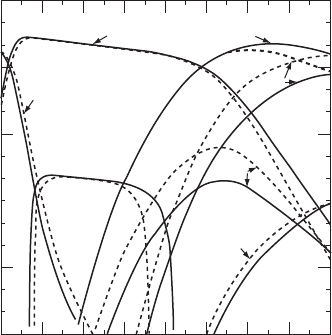
392 SYNTHESIS AND PROCESSING OF MATERIALS
where PH
2
is the partial pressure of H
2
in the system. The pressures in this equation
are expressed in atmospheres.
By requiring conservation of H atoms in the fluxes of atoms and molecules inci-
dent on and leaving either the diamond or the graphite surface, predictions for the
evaporation rates R
e
C
x
H
y
,T can be obtained. Deposition rates are then obtained
from
R
d
C D IC R
e
C, W21.29
where I(C) is the net flux of incident C atoms and R
e
(C) is the net flux of C atoms
leaving the surface. The evaporation rates R
e
C
x
H
y
,T and deposition rates R
d
of
diamond and graphite are presented as functions of temperature in Fig. W21.29 for a
mixture of 1% CH
4
in H
2
at P D 5 ð 10
3
Pa. It can be seen that the evaporation rates
of C
x
H
y
species are predicted to be higher above diamond (dashed curves) than above
graphite (solid curves), as expected from the slightly higher free energy of formation
of diamond relative to graphite. Under the conditions presented in Fig. W21.29, there
exists an intermediate temperature range, from T D 910 to 2295 K, where diamond
is stable relative to hydrogen. For T<910 K diamond is etched via the formation of
CH
4
g while for T>2295 K etching via the formation of C
2
H
2
g dominates.
The data presented in Fig. W21.29 can be used to construct the CVD phase diagram
for the C–H system shown in Fig. W21.30. Here the regions of stability of solid carbon
(i.e., diamond or graphite) are presented at 5 ð 10
3
Pa as functions of temperature and
reactant ratio C/C C H. In this case there exists a region where diamond is predicted
to be the only stable phase of solid carbon. This occurs because the phase boundary of
graphite has been shifted to the right by taking into account the enhanced etching of
graphite by atomic hydrogen. Experimental data points for the deposition of diamond
10
21
10
20
10
19
10
18
5
2
5
2
5
2
5
2
10
22
10
23
5
2
1000 2000 3000 4000
R
e
(cm
−2
sec
−1
)
T (K)
CH
4
H
2
H
C
2
H
C
2
H
2
C(s)
CH
Figure W21.29. Predictions of the quasiequilibrium model for the evaporation rates
R
e
C
x
H
y
,Tof C
x
H
y
vapor species and the deposition rates R
d
T of either diamond or graphite
are presented as functions of temperature for a mixture of 1% CH
4
in H
2
at P D 5 ð 10
3
Pa.
[From M. Sommer and F. W. Smith, High Temp. Sci., 27, 173 (1989). Reprinted by permission
of Humana Press, Inc.]
